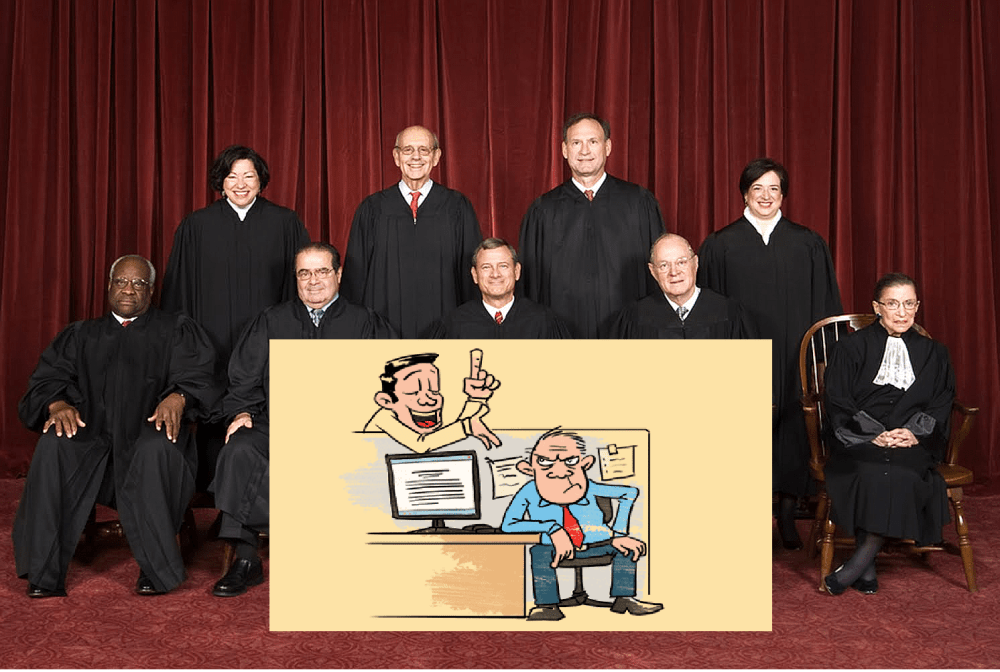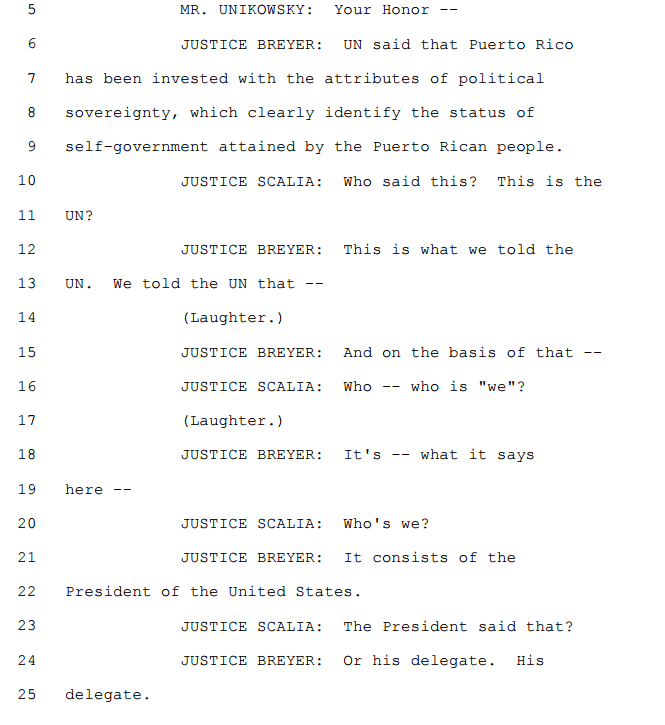
Supreme Court oral arguments are traditionally thought of as a time for the Justices to interact with and ask question of attorneys in a case. One of the lesser thought of aspects of oral arguments has to do with the interaction among the Justices. Over the years several studies and articles have looked at this interaction to see what information can be extracted in terms of group dynamics and collegiality, the Justices’ potential merits votes, and the tenor of oral arguments in general.
This post focuses on the interaction among the Justices in this Term’s oral arguments. In particular it looks at when Justices interrupt each other and when they reference one another with their utterances. To code interruptions, I went through the Term’s oral argument transcripts and looked for instances when one Justice began speaking and another Justice interjected before the first Justice’s statement was complete and before an attorney spoke.
Some of this coding is subjective since the written transcripts do not cover all of the nuances that are apparent in the audio recordings. For instance, I did not code any interruptions in the following dialogue from Puerto Rico v. Sanchez Valle:

As interruptions can occur both intentionally and unintentionally, and can, but do not necessarily affect the interrupted Justice’s speech, I do not make any value judgments on the effect of an interruption. Also, Chief Justice Roberts’ role presiding over the arguments forces him to occasionally interject in a non-disruptive fashion to direct or end a conversation.
The other type of interaction I focus on is when a Justice references another Justice in an utterance. As with interruptions, these instances can take a positive or negative tone but in either case they highlight the other Justice and occasionally bring the conversation back to the referenced Justice.
Here are several examples from this Term of Justices bringing the conversation back to questions from another Justice
“JUSTICE KENNEDY: Justice Kagan can ask her own question” (Wittman v. Personhuballah)
“CHIEF JUSTICE ROBERTS: Justice Kagan, did you have a question?” (Halo Electronics v. Pulse Electronics)
“CHIEF JUSTICE ROBERTS: Why don’t you take — the — the rest of us are interested in your answer to Justice Breyer.” (Sturgeon v. Frost)
There are also instances where the Justices point out their disagreements or divergent opinions from other Justices:
“JUSTICE SOTOMAYOR: I’m very surprised that Justice Alito doesn’t know that most of these warrants are automatic. If you don’t pay your fine within a certain amount of days, they’re issued virtually automatically.” (Utah v. Strieff)
“JUSTICE KENNEDY: I — I don’t understand why the statute that Justice Breyer is focusing on, that part of the statute.” (Sturgeon v. Frost)”
“JUSTICE SOTOMAYOR: The principle of contract interpretation — I — I beg to differ with Justice Scalia,” (DirecTV v. Imburgia)
Finally there are instances of clarification and acknowledgement:
“JUSTICE KENNEDY: Justice Scalia is asking what — what — what the test — what is the test here?” (Harris v. Arizona Independent Redistricting)
“JUSTICE KENNEDY: I — I inadvertently interrupted Justice Ginsburg, but in the — in the 19 cases here, you don’t find that principle?” (Bank Markazi v. Peterson)
One other important caveat is that all Justices do not necessarily talk in all parts of oral arguments (see the example in a previous post regarding U.S. v. Texas). For instance, oftentimes Justices Breyer, Ginsburg, Sotomayor and Kagan interact when one attorney is presenting his or her case while Justices Alito, Roberts, Kennedy and Scalia (prior to his death) interact with the opposing attorney. This complicates any interpretation of the results of the Justices’ interactions.
With an understanding of the multiple reasons for and effects of the Justices’ interruptions and references we can take a look at the Justices’ interactions from this Term.
First for aggregate counts: the figure below shows the number of times each Justice was interrupted by another Justice this Term from least to most.

Justice Sotomayor was interrupted the most followed by Justice Kagan. Justice Thomas who only spoke during one oral argument was not interrupted and Justice Scalia who only participated in a portion of this Term’s oral arguments was interrupted the next least. There is a large dip from the 50 times Justice Kagan was interrupted to the 36 times Justice Breyer was interrupted. After Justice Breyer the number of times the Justices were interrupted is fairly consistent through the 26 for Justice Scalia.
The next Figure looks at the number of times the Justices acted as interrupters of other Justices.

Justice Kennedy was the most frequent interrupter. This is not wholly surprising since he is often more engaged than other Justices in both sides arguments in a given case. Justice Roberts interrupted the next most although some of these may have actually been instances of Justice Roberts directing conversation based on his position as Chief. After this, similar to the number of times the Justices were interrupted, there is a large drop-off to Justice Breyer who interrupted the others the next most with 39 interruptions. As with the interrupted Justices, Justices Thomas was also not interrupted in the one oral argument he participated in this Term.
The next set of figures look at the number of times the Justices reference each other.

The most referenced Justice is also the Justice that speaks the most: Justice Breyer. Justice Breyer who was referenced 52 times by the other Justices often uses hypothetical scenarios in his questions, which other Justices reference or attempt to clarify. Justice Kagan is next after Justice Breyer with 41 references. In several instances the other Justices provide an opportunity for Justice Kagan to speak after she was previously interrupted. Justice Thomas is referenced three times in total – far fewer than any of the other Justices.
Next is the chart looking at the number of times the Justices reference each other.

Justice Kennedy, similar to his role as the most active interrupter is also the Justice that references the other Justices the most with 60 references. Justice Kagan also has a large number of references with 52. While Justices Sotomayor and Breyer make over forty references each, Justices Ginsburg and Roberts each have fewer than 30 references, and Justices Scalia (who only participated in a subset of oral arguments) and Alito have fewer than 20 references apiece.
There are several specific interactions between Justices worthy of note. Of the 38 times Justice Alito is referenced, 20 were made by Justice Kennedy. The Justices that reference Justice Alito the next most are Justices Sotomayor and Breyer with 5 mentions each. Justice Kennedy also does not reference another Justice more than 10 times (he references Justice Kagan 10 times). Justice Breyer is referenced by Justices Sotomayor and Justice Kagan more than each references any other Justice with 15 and 13 references respectively. By contrast Justice Sotomayor only references Justice Kennedy once.
The greatest number of interruptions from one Justice to another is Justice Kennedy with 14 interruptions of Justice Sotomayor. Justice Kennedy is also tied for the second most with 13 interruptions of Justice Ginsburg (which accounts for almost half of the 31 total times Justice Ginsburg was interrupted). Justice Roberts interrupted Justices Kagan and Sotomayor 13 times each as well. While Justice Kennedy heavily referenced Justice Alito, he only interrupted him four times. Some of the Justices traditional alignments help to account for greater or fewer interruptions – for instance Justice Sotomayor only interrupted Justice Ginsburg once, while others do not fit this mold (Justice Alito also only interrupted Justice Ginsburg once).
While there are discernible trends from this data that speak to the oral relationships between Justices, much occurs within the context of each argument. Some of the trends make intuitive sense – such as the many times Justice Breyer is mentioned by other Justices, while others such as the number of times Justice Kennedy references Justice Alito appear based on individual rapport. Just as some of the behavior is easier to square with common understandings of the Justices’ patterns in oral arguments, some is easier to interpret as strategic versus purely conversational. Unfortunately without information about the Justices’ positions before oral arguments and in the conferences after oral arguments, it is difficult to ascertain the impact these interactions have on their earlier impressions of each case.
On Twitter: @AdamSFeldman
This gender pattern is very consistent with the findings in our book The Silent Sex, Karpowitz and Mendelberg 2014, Princeton U Press, where we count every interruption in small group discussion
LikeLiked by 1 person